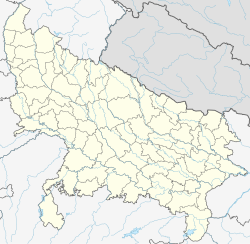Ambara Pachhim
In today's world, Ambara Pachhim has become a topic of great relevance and interest to a wide range of individuals, organizations and communities. With the passage of time, Ambara Pachhim has gained importance and attention, generating debates, research and discussions in different areas. Whether due to its impact on society, its relevance in academia, its influence on popular culture or its relevance in history, Ambara Pachhim continues to be a topic of constant interest and discussion. In this article, we will explore different aspects of Ambara Pachhim, from its origin to its present day, analyzing its impact and relevance in various contexts.
Ambara Pachhim
Ambāra Pachhim | |
|---|---|
Village | |
 Map showing Ambara Pachhim (#871) in Lalganj CD block | |
| Coordinates: 26°07′42″N 80°56′49″E / 26.128368°N 80.947028°E[1] | |
| Country India | |
| State | Uttar Pradesh |
| District | Raebareli |
| Area | |
• Total | 8.742 km2 (3.375 sq mi) |
| Population (2011)[2] | |
• Total | 5,223 |
| • Density | 600/km2 (1,500/sq mi) |
| Languages | |
| • Official | Hindi |
| Time zone | UTC+5:30 (IST) |
| Vehicle registration | UP-35 |
Ambara Pachhim is a village in Lalganj block of Rae Bareli district, Uttar Pradesh, India.[2] It is located 5 km from Lalganj, the block and tehsil headquarters.[3] As of 2011, it has a population of 5,223 people, in 941 households.[2] It has three primary schools and one medical clinic.[2] Ambara Pachhim hosts a market twice per week, on Mondays and Thursdays; vegetables and cloth are the main items traded.[4]
The 1961 census recorded Ambara Pachhim as comprising 9 hamlets, with a total population of 2,252 people (1,092 male and 1,160 female), in 426 households and 376 physical houses.[4] The area of the village was given as 2,204 acres and it had a post office at that point.[4] Average attendance of the twice-weekly market was about 150 people.[4]
The 1981 census recorded Ambara Pachhim (as "Ambara Paschim") as having a population of 3,151 people, in 558 households, and having an area of 891.93 hectares.[3] The main staple foods were listed as wheat and rice.[3]
References
- ^ "Geographic Names Search WebApp". Do a radial search using these coordinates here.
- ^ a b c d e "Census of India 2011: Uttar Pradesh District Census Handbook - Rae Bareli, Part A (Village and Town Directory)" (PDF). Census 2011 India. pp. 288–306. Retrieved 19 August 2021.
- ^ a b c Census 1981 Uttar Pradesh: District Census Handbook Part XIII-A: Village & Town Directory, District Rae Bareli (PDF). 1982. pp. 156–7. Retrieved 19 August 2021.
- ^ a b c d Census 1961: District Census Handbook, Uttar Pradesh (39 - Raebareli District) (PDF). Lucknow. 1965. pp. 175, lxxvi-lxxvii of section "Dalmau Tahsil". Retrieved 19 August 2021.
{{cite book}}: CS1 maint: location missing publisher (link)
